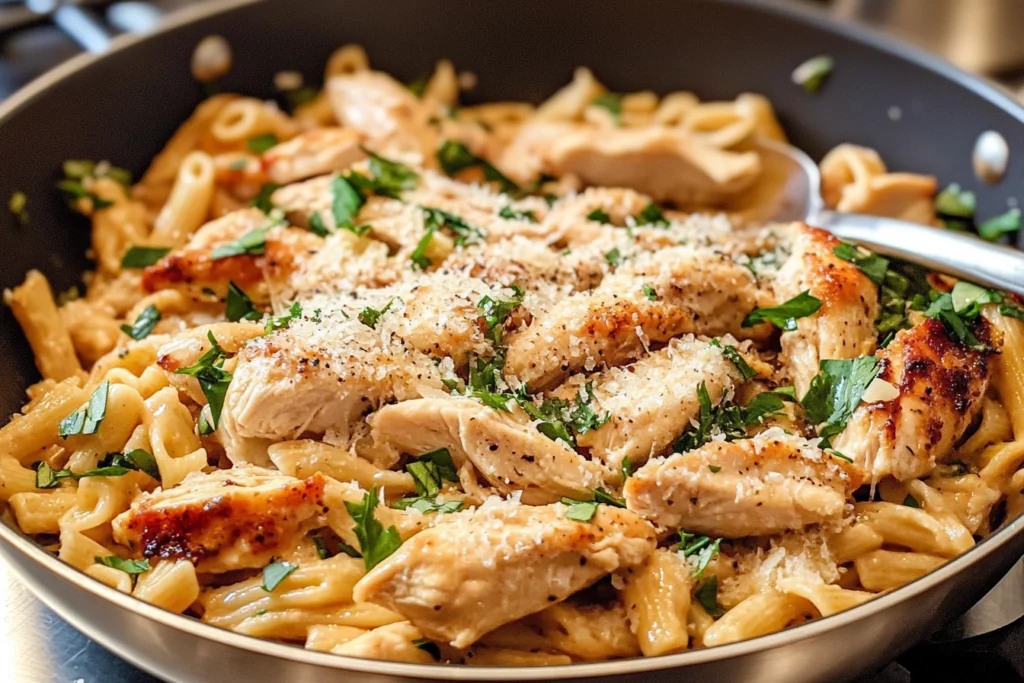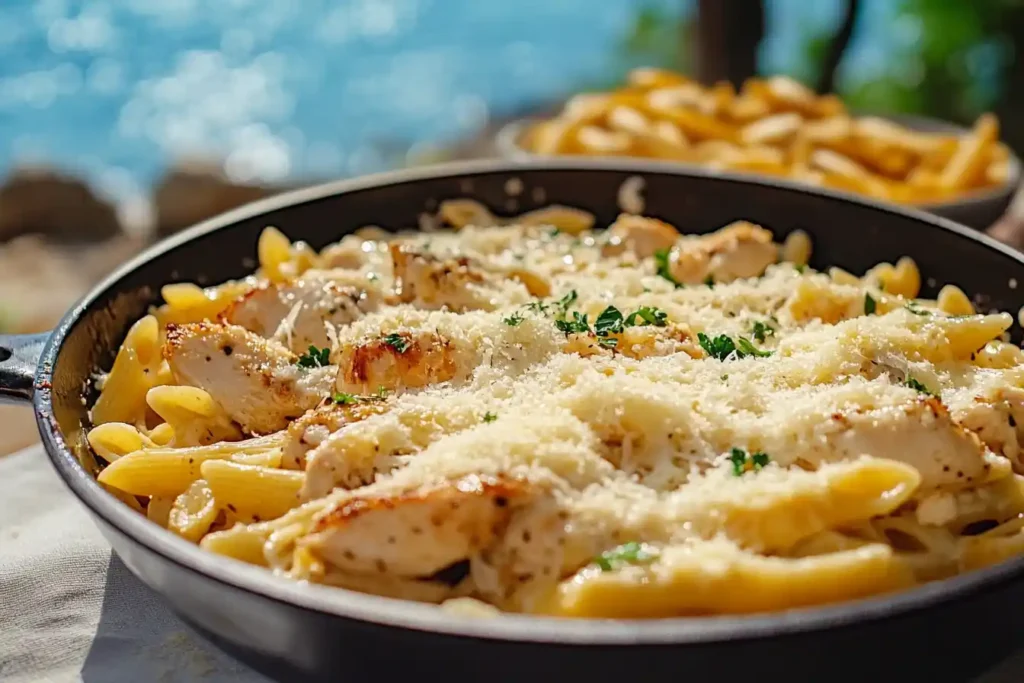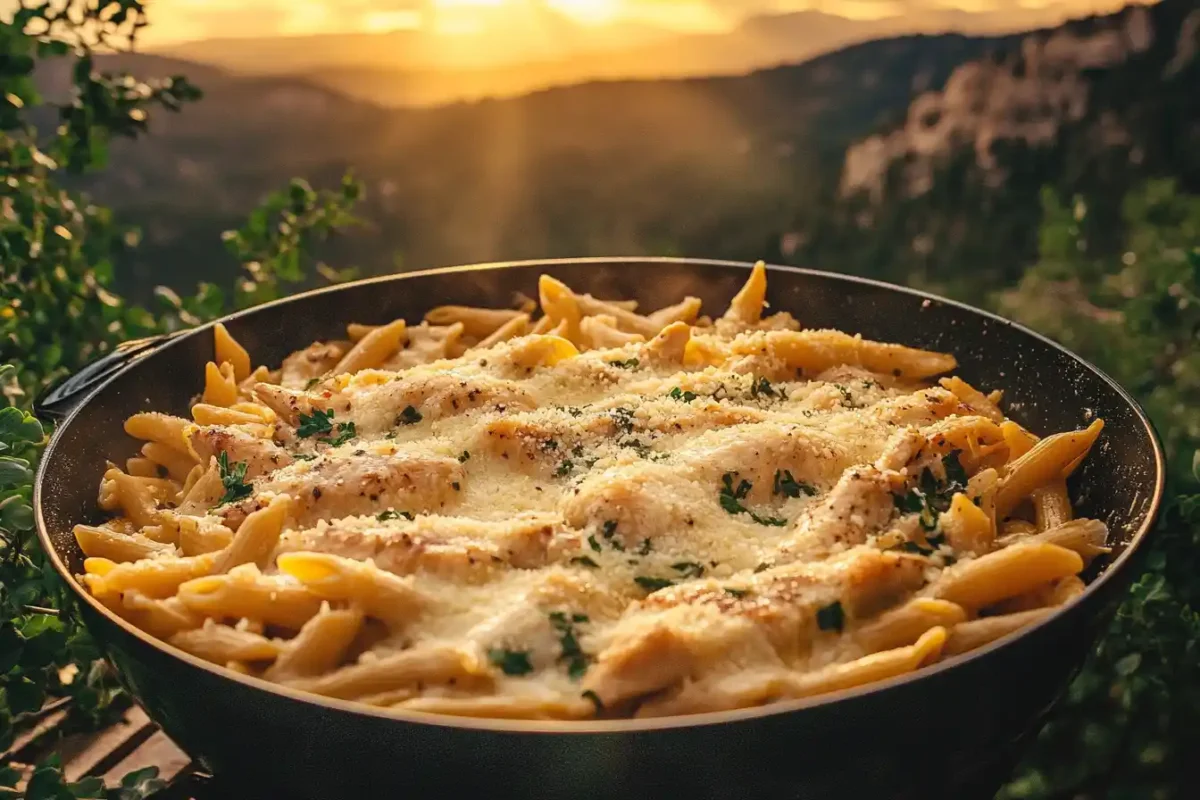Discover the ultimate garlic parmesan chicken pasta recipe that’s creamy, flavorful, and easy to make at home.
Introduction
When it comes to comforting meals that taste good and make you feel great, garlic parmesan chicken pasta is a top favorite. This dish combines tender chicken, flavorful parmesan cheese, and fragrant garlic, creating a creamy and delicious meal perfect for any occasion. Whether you’re making a quick dinner or cooking for guests, this recipe is sure to impress with its bold flavors and pleasing texture. Plus, readers will find easy cooking tips, ideas to make the dish their own, and advice to improve both taste and presentation.
Cooking Tips: Ingredients for Garlic Parmesan Chicken Pasta
To craft the perfect garlic parmesan chicken pasta, gathering high-quality ingredients is paramount. Here’s what you’ll need:
- Chicken Breasts: 2 large, boneless, skinless — opting for fresh, organic chicken ensures tenderness and flavor.
- Pasta: 12 ounces of your favorite type (fettuccine, penne, or spaghetti work exceptionally well) — choose whole wheat or gluten-free options for added nutritional benefits.
- Garlic: 4 cloves, minced — fresh garlic imparts a more vibrant flavor compared to pre-minced varieties.
- Parmesan Cheese: 1 cup, freshly grated — freshly grated cheese melts better and enhances the sauce’s creaminess.
- Heavy Cream: 1 cup — for a rich and smooth sauce.
- Butter: 2 tablespoons — unsalted butter allows for better control over the dish’s saltiness.
- Olive Oil: 2 tablespoons — extra virgin olive oil adds depth to the flavor profile.
- Salt and Pepper: to taste — essential for seasoning and balancing flavors.
- Fresh Parsley: chopped, for garnish — adds a touch of freshness and color.
Tips for Selecting Ingredients
- Chicken: Look for chicken breasts that are firm and pink without any discoloration. Organic or free-range chicken can offer superior taste and texture.
- Pasta: Experiment with different pasta shapes to see which you prefer. Each type holds the sauce differently, affecting the overall experience.
- Cheese: Investing in high-quality parmesan cheese can make a significant difference in the dish’s flavor. Avoid pre-packaged shredded cheese with anti-caking agents.
Cooking Tips: Preparation Steps for Garlic Parmesan Chicken Pasta
Making perfect garlic parmesan chicken pasta takes a few important steps, each essential for the dish to turn out well. Follow these carefully to enjoy a delicious meal.
Preparing the Chicken
- Season the Chicken: Begin by seasoning the chicken breasts generously with salt and pepper on both sides. This step is essential as it enhances the natural flavors of the meat.
- Cook the Chicken: In a large skillet, heat the olive oil over medium-high heat. Once the oil is shimmering, add the chicken breasts. Cook for approximately 6-7 minutes on each side, or until the chicken is fully cooked through and boasts a golden-brown exterior. For precision, use a meat thermometer to ensure the internal temperature reaches 165°F.
- Rest the Chicken: After cooking, transfer the chicken to a plate and let it rest for about 5 minutes. Resting allows the juices to redistribute, ensuring the chicken remains moist and flavorful. Subsequently, slice the chicken into thin strips to facilitate even distribution throughout the pasta.
Cooking the Pasta
- Boil the Water: Fill a large pot with water and bring it to a rolling boil. Adding a generous amount of salt (approximately 1-2 tablespoons) not only flavors the pasta but also enhances its texture.
- Cook the Pasta: Introduce the pasta to the boiling water. Cook according to the package instructions until it reaches an al dente texture—tender yet firm to the bite. This ensures the pasta maintains its integrity when mixed with the creamy sauce.
- Drain the Pasta: Once cooked, reserve about a cup of pasta water to adjust the sauce’s consistency if needed. Then, drain the pasta using a colander and set it aside. For more insights on achieving the perfect pasta texture,
Making the Garlic Parmesan Sauce
- Sauté the Garlic: In the same skillet used for the chicken, melt the butter over medium heat. Add the minced garlic and sauté for about 1-2 minutes until it becomes fragrant. Be cautious not to burn the garlic, as it can turn bitter.
- Add the Cream: Pour in the heavy cream, stirring continuously to blend it with the garlic and butter. Allow the mixture to simmer for a few minutes, which helps in reducing the sauce slightly and enhancing its richness.
- Incorporate the Parmesan: Gradually add the freshly grated parmesan cheese to the simmering cream. Stir constantly to ensure the cheese melts evenly, resulting in a smooth and velvety sauce.
Combining Everything
- Mix the Pasta and Sauce: Add the cooked pasta directly into the skillet with the garlic parmesan sauce. Toss the pasta thoroughly to ensure every strand is enveloped in the creamy mixture. If the sauce appears too thick, gradually add some reserved pasta water until the desired consistency is achieved.
- Add the Chicken: Incorporate the sliced chicken into the pasta, distributing it evenly throughout the dish. This ensures each serving contains a balanced amount of protein and sauce.
- Season to Taste: Taste the pasta and adjust the seasoning with additional salt and pepper if necessary. This final step allows you to fine-tune the flavors to your preference.

Cooking Tips: Garlic Parmesan Chicken Pasta
Making the perfect garlic parmesan chicken pasta takes careful preparation and a few important steps. Here are some helpful tips to improve your cooking.
- Ensure Tender Chicken: Overcooking chicken breasts can lead to dryness. To prevent this, use a meat thermometer to monitor the internal temperature, ensuring it reaches 165°F without exceeding it.
- Balance Flavors: Parmesan cheese is inherently salty. Therefore, taste the sauce before adding extra salt. This helps in maintaining a harmonious balance of flavors without overwhelming saltiness.
- Perfect Pasta Texture: Cooking pasta to an al dente texture is crucial. It not only provides a pleasant bite but also prevents the pasta from becoming mushy when mixed with the sauce. Additionally, reserving some pasta water allows you to adjust the sauce’s thickness as needed.
- Storage and Reheating: Store any leftovers in an airtight container in the refrigerator for up to 4 days. When reheating, add a splash of milk or cream to restore the sauce’s creaminess, as it may thicken upon cooling.
- Enhance Garlic Flavor: To intensify the garlic flavor, consider Baking the garlic beforehand. Roasted garlic adds a sweeter, more mellow taste compared to raw minced garlic.
- Use Fresh Herbs: Garnishing with fresh parsley not only Completes the visual appeal but also adds a fresh, herby note that Completes the richness of the dish.
Variations
One of the best things about garlic parmesan chicken pasta is how simple it is to change. For example, you can tweak the recipe to match your taste or diet. You can still enjoy its creamy and delicious flavor in many different ways. If you want a lighter choice, try using almond or cashew milk instead of heavy cream. You can also add fresh foods like sun-dried tomatoes or spinach. This dish goes well with different kinds of pasta, like penne, fettuccine, or even zucchini noodles for a low-carb option. In short, garlic parmesan chicken pasta is a dish you can make your own.
Adding Vegetables
Incorporating vegetables into your pasta not only boosts its nutritional value but also adds vibrant colors and textures. Consider the following options:
- Broccoli: Steamed or roasted broccoli florets add a delightful crunch and a burst of green color. They also provide essential vitamins and fiber.
- Spinach: Fresh spinach leaves wilt beautifully into the creamy sauce, offering a mild, earthy flavor and a boost of iron and vitamins.
- Mushrooms: Sautéed mushrooms introduce an earthy depth to the dish. Varieties like cremini or shiitake work particularly well.
- Sun-Dried Tomatoes: For a tangy twist, add sun-dried tomatoes. They contribute a concentrated tomato flavor that complements the creamy sauce.
Using Different Cheeses
While parmesan cheese is traditional, experimenting with other cheeses can bring new dimensions to your pasta:
- Mozzarella: Incorporating mozzarella creates a gooey, stretchy texture that kids and cheese lovers will adore.
- Gruyère: This cheese adds a nutty, slightly sweet flavor, enhancing the dish’s complexity.
- Pecorino Romano: For a sharper, more pronounced cheese flavor, substitute some or all of the parmesan with pecorino romano.
- Gorgonzola: Introducing gorgonzola can lend a creamy, tangy flavor, perfect for those who enjoy bold tastes.
Making It Spicy
If you prefer a bit of heat, there are several ways to spice up your garlic parmesan chicken pasta:
- Red Pepper Flakes: Sprinkle red pepper flakes into the sauce while sautéing garlic to infuse the dish with a subtle heat.
- Hot Sauce: Add a few dashes of your favorite hot sauce to the cream mixture for a customizable spice level.
- Spicy Sausage: Substitute chicken with spicy Italian sausage to introduce both heat and a robust flavor profile.
- Jalapeños: Fresh or pickled jalapeños can add a vibrant kick and a hint of acidity to balance the creaminess.
Dairy-Free Option
For those who are lactose intolerant or prefer a dairy-free diet, consider these substitutions:
- Coconut Cream: Replace heavy cream with coconut cream for a creamy texture without dairy.
- Nutritional Yeast: Use nutritional yeast instead of parmesan cheese to achieve a cheesy flavor without the dairy.
- Vegan Butter: Substitute butter with vegan butter or olive oil to maintain the sauce’s richness.
Low-Carb Version
To make a low-carb version of this dish, swap traditional pasta with alternatives like:
- Zucchini Noodles (Zoodles): Spiralized zucchini offers a fresh, light base that absorbs the creamy sauce beautifully.
- Spaghetti Squash: When cooked, spaghetti squash strands mimic the texture of pasta, providing a nutritious and low-carb alternative.
- Shirataki Noodles: These noodles are low in calories and carbohydrates, making them an excellent choice for those monitoring their intake.
Cooking Tips: Nutritional Information for Garlic Parmesan Chicken Pasta
Knowing what’s in your food is important for staying healthy. A regular serving of garlic parmesan chicken pasta includes the following:
- Calories: 650 kcal
- Protein: 35g
- Carbohydrates: 60g
- Fat: 25g
- Fiber: 3g
- Sugar: 4g
Note: Nutritional values may vary based on specific ingredients and portion sizes used.
Cooking Tips: Health Benefits of Main Ingredients in Garlic Parmesan Chicken Pasta
- Chicken Breast: A lean source of protein, essential for muscle growth and repair.
- Garlic: Known for its immune-boosting properties and rich in antioxidants.
- Parmesan Cheese: Provides calcium for bone health and contains beneficial amino acids.
- Pasta: A good source of energy through carbohydrates, especially when opting for whole grain varieties.
- Olive Oil: Rich in healthy monounsaturated fats, which are beneficial for heart health.
Tips for a Healthier Dish
- Use Whole Grain Pasta: Switching to whole wheat pasta increases fiber intake, promoting better digestion.
- Reduce Butter: Cutting down on butter can lower the overall fat content without compromising flavor.
- Incorporate More Vegetables: Adding a variety of vegetables not only enhances the dish’s nutritional value but also adds volume, making the meal more filling.
- Control Portion Sizes: Being mindful of portion sizes helps in managing calorie intake, especially when pairing with high-calorie sides.

Cooking Tips and Serving Suggestions for Garlic Parmesan Chicken Pasta
- Garnish: Sprinkle freshly chopped parsley and an extra dash of parmesan cheese on top. This not only adds color but also an extra layer of flavor.
- Side Dishes: Complement the pasta with a crisp green salad dressed in a light vinaigrette or serve alongside garlic bread for a hearty meal.
- Beverage Pairings: A glass of white wine, such as Chardonnay or Sauvignon Blanc, pairs wonderfully with the creamy sauce. For non-alcoholic options, consider sparkling water with a slice of lemon.
- Plating Tips: Use wide, shallow bowls to showcase the pasta’s creamy texture and vibrant garnishes. Twirl the pasta neatly for an elegant presentation.
- Add Fresh Herbs: Incorporating fresh herbs like basil or thyme can add a fragrant touch and elevate the dish’s aesthetic appeal.
Frequently Asked Questions About Garlic Parmesan Chicken Pasta
How to buy fresh garlic?
Choose firm bulbs with tight skins and no signs of sprouting. Fresh garlic should feel heavy for its size and free from soft spots or mold.
How long does garlic chicken pasta last in the fridge?
When stored in an airtight container, garlic chicken pasta stays fresh for up to 4 days in the refrigerator. Let the dish cool to room temperature before refrigerating to keep its quality. When reheating, add a little milk or cream to make the sauce creamy again, as it may get thicker after cooling.
Can I freeze garlic parmesan chicken pasta?
Yes, you can freeze the dish for up to 2 months. To freeze, let the pasta cool completely, then transfer it to a freezer-safe container or zip-top bag. When ready to eat, thaw overnight in the refrigerator and reheat on the stovetop or in the microwave, adding a bit of cream or milk to restore the sauce.
What can I substitute for heavy cream?
If you’re looking for alternatives to heavy cream, you can consider options such as half-and-half, whole milk combined with a tablespoon of butter, or coconut milk for a dairy-free alternative. However, keep in mind that each substitute will slightly alter the sauce’s texture and flavor. Therefore, you should choose the option that best suits your dietary preferences and desired outcome.
Conclusion
Garlic parmesan chicken pasta is more than just a meal; it’s a celebration of rich flavors and comforting textures that bring joy to the dining table. Its creamy sauce, tender chicken, and savory garlic make it a favorite among family and friends alike. Moreover, the recipe’s versatility allows for endless customization, ensuring it can cater to various tastes and dietary needs. Ever wondered why it’s called “Marry Me” Pasta? Whether you’re a seasoned cook or a kitchen novice, this dish is straightforward to prepare and promises impressive results every time. Therefore, embrace this delightful recipe and enjoy crafting a meal that’s both delicious and satisfying. Bon appétit!

